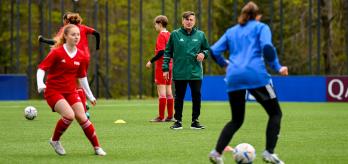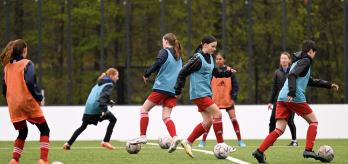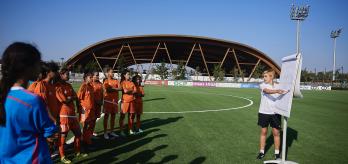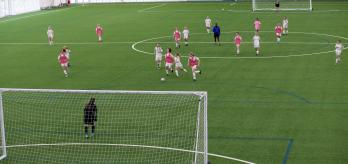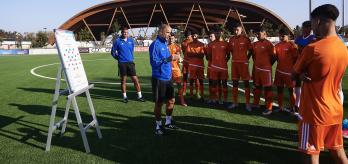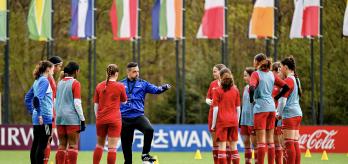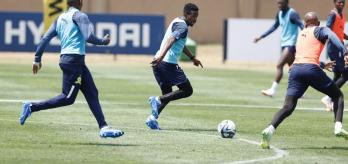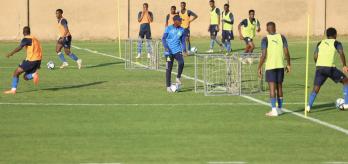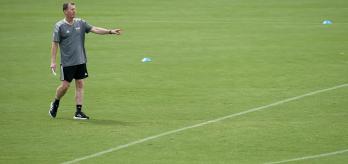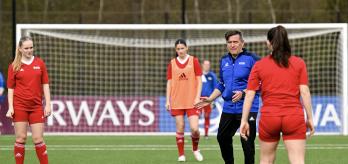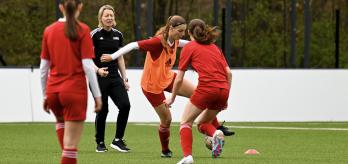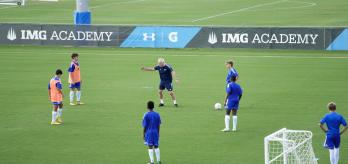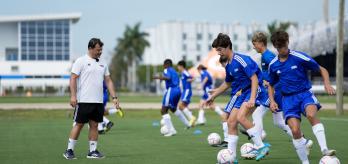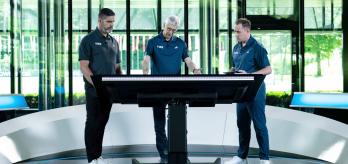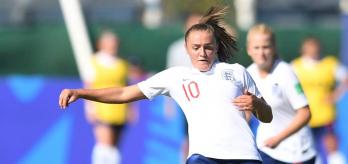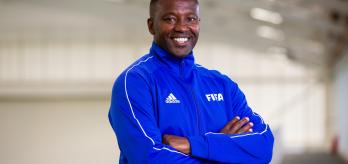To help players improve their understanding, Dennis Hediger, a youth development coach at FC Basel and former FC Thun midfielder, has designed a training session in four parts. Players begin with a combination play exercise, play a small-sided game and conclude with two different 8v8 matches. Explosive sprints, sudden changes of tempo, and perfectly coordinated passes are used to get the ball through the defence and bear down on goal. With these skills, players will be well-prepared to create chances and score against mid- and low blocks.
Session overview
- Part 1: up-back-through passing pattern.
- Part 2: 3v3+3.
- Part 3: 8v8 with 3 zones.
- Part 4: 8v8 without zones.
Key coaching points
- To get the ball in behind the defence, you need a well-aimed pass and a well-timed run – both elements are essential.
- Changes of tempo are useful for breaking through defensive lines.
- Players should always be watching for an open ball, which is their signal to start sprinting forward and make themselves available for a pass.
- Players not directly involved in the play should immediately push up to support the receiver.
The video clips below illustrate this session's key concepts with real examples from high-level international youth football.
Part 1: up-back-through passing pattern
With no opposition pressure and plenty of repetitions, this exercise allows players to quickly internalise combination patterns linking the midfield to the attack. A pass back from midfield sets up the centre-back to play a penetrating ball to the striker, which is followed by a quick lay-off to an attacking midfielder and explosive sprints behind the defence to finish. This effective link-breaking move depends on solid passing, running and receiving technique, dynamic play, good communication and a sudden change of tempo between the two combinations.
-
Divide players into 2 groups of 9, with 1 goalkeeper in each group.
-
For each group, set up a station with 3 mannequins, 6 starting positions and a goal.
-
The first player (A) plays a pass towards the first mannequin for the holding midfielder (B) to run onto.
-
B takes a touch to control the ball and then passes back to C.
-
C takes the ball forward past the second mannequin, then plays a weighted pass towards the third mannequin for the striker (D) to run onto.
-
D lays it off to the attacking midfielder (E), and then both D and the other attacking midfielder (F) drive towards goal.
-
E passes to either D or F.
-
Whichever player gets the ball can either pass to the other or finish directly.
-
Each player rotates to the next position.
-
D can lay it off to either E or F. Whoever gets the ball can then pass to either D or the other attacking midfielder, who should both be showing for the pass. Diagonal passes are a valid option here, too.
-
Holding midfielder (B): check away from your "opponent" to receive the ball.
-
Centre-back (C): always take your first touch forward into open space. Keep your eye on the striker and play a weighted pass to them.
-
Striker (D): maintain an open position facing the ball and check away from your "opponent" to receive it. Once you have the ball, look for your best passing option. Don’t ball-watch after laying it off; immediately sprint into space.
-
Striker and attacking midfielders: anticipate one another's movements and coordinate them as a group. Be ready to decide whether to shoot at goal or pass/cross to a team-mate if you get the ball.
-
All players: Coordinate the timing of your runs and passes, building in a significant change of rhythm between the two combinations. Always run onto the ball; don’t go to your final position before the pass arrives. Play all passes and lay-offs with the appropriate weight and pace, and aim them at the correct foot (depending on the receiver's position).
Part2: 3v3+3
The passing patterns in this game are almost the same as those in the warm-up activity, but now players have to execute them in a very tight space while also contending with opponents. This adds relevance and a realistic element by forcing players to make decisions under pressure. The ball carrier always has to be looking for the best-positioned receiver, while the players off the ball have to decide whether to show for it or run into space for the next pass. At the same time, the set-up also guarantees plenty of repetitions to make those lessons stick.
-
Mark out a 30x15m area on each side of the pitch as shown, with a halfway line across each pitch and plenty of extra balls on the sidelines.
-
Assign 2 teams of 3 plus 3 "jokers" (neutral players) to each pitch.
-
The neutral players must stay in their assigned positions: one on the halfway line and one on each end line.
-
The teams face off in one of the halves.
-
The coach plays a ball onto the pitch to start the game.
-
The neutral players help whichever team has the ball. All players have unlimited touches except the neutral ones, who are limited to one.
-
To score, players must play a combination (pass and receive) with the neutral player on the halfway line, then complete a pass across the halfway line to the neutral player on the far end line.
-
Play then shifts to the other half, and the first team to receive the ball from the neutral player on the end line becomes the new attacking team.
-
Variation 1 (third player run): players can score two points by playing a one-two with the central neutral player and then completing a pass to a team-mate who has run across the halfway line.
-
Variation 2 (direct through-ball): players can also bypass the central neutral player and score with a pass (on the ground or in the air) to a team-mate in the opposite half. This should lead to more runs in behind the opposition’s defensive line.
-
Take advantage of overloads by using the full width of the pitch. Find the best positions for controlling the ball and moving the attack forward. Cover the wings as well as the middle, and constantly adjust your position so that you are always available.
-
Be patient! Try to stay in possession (and in overload situations) for as long as necessary while you wait for the right opening.
-
Avoid turnovers with solid technique, focusing on your first touch (receiving and controlling the ball) and the quality of your passing.
-
Try to play forward as often and soon as possible to score the most points.
-
Be prepared to immediately switch to counter-pressing if you lose the ball, so that you can win it back as quickly as possible.
Part 3: 8v8 with 3 zones

This conditioned game is even more realistic while still providing plenty of repetitions. The basic objective is to play out from the back and find an open midfielder, who turns and then tries to play a ball in behind the defensive line. Players must stay in their assigned zones until the ball is played forward, which creates space behind defenders, but also forces receivers to anticipate the forward pass. Both passers and receivers must be flexible and dynamic, adapting to shifts in the defensive line in order to find the gaps and connect through them with perfectly timed runs and passes. This is excellent training for opening up space and creating chances against a mid-block defence.
-
Mark out an 80x42m pitch divided into thirds by 2 "offside" lines.
-
Divide players into 2 teams of 8 plus goalkeepers. Each team sets up in a 3-2-3 formation: 3 players plus the goalkeeper in the defensive third, 2 in the midfield, and 3 in the final third.
-
The game begins as a 4v3 in the attacking team's defensive third (attacking team’s defenders and goalkeeper versus defending team's attackers). Players are not allowed to cross the offside lines until the ball is played across them.
-
To progress, the attacking team must pass the ball into the middle third, where the situation changes to a 5v3 (attacking team’s midfielders and strikers versus defending team's defenders).
-
The defending midfielders do not actively try to intercept the ball. This allows the midfielders in possession to turn and move forward with a pass across the second offside line, culminating in a shot on goal.
-
Same as above, except now players can cross the offside line ahead of the pass. This means attackers can use their runs to drag defenders out of position, creating space for potential through-balls.
-
Build-up play: use the goalkeeper to create overloads and circulate the ball, watching for the right moment to pass across the line.
-
Attacking players: position yourself so that your field of vision is as wide as possible. Make direct or angled runs into space (in the opposite direction to the defender), and use deep runs to drag defenders out of position. Always start your runs before the pass is played.
-
All players: watch for space created by team-mates' runs. As soon as the ball crosses the line, move as a unit towards goal and try to get a shot away quickly, before your opponents can win the ball back. You only get one chance, so time your runs perfectly!
Part 4: 8v8 without zones
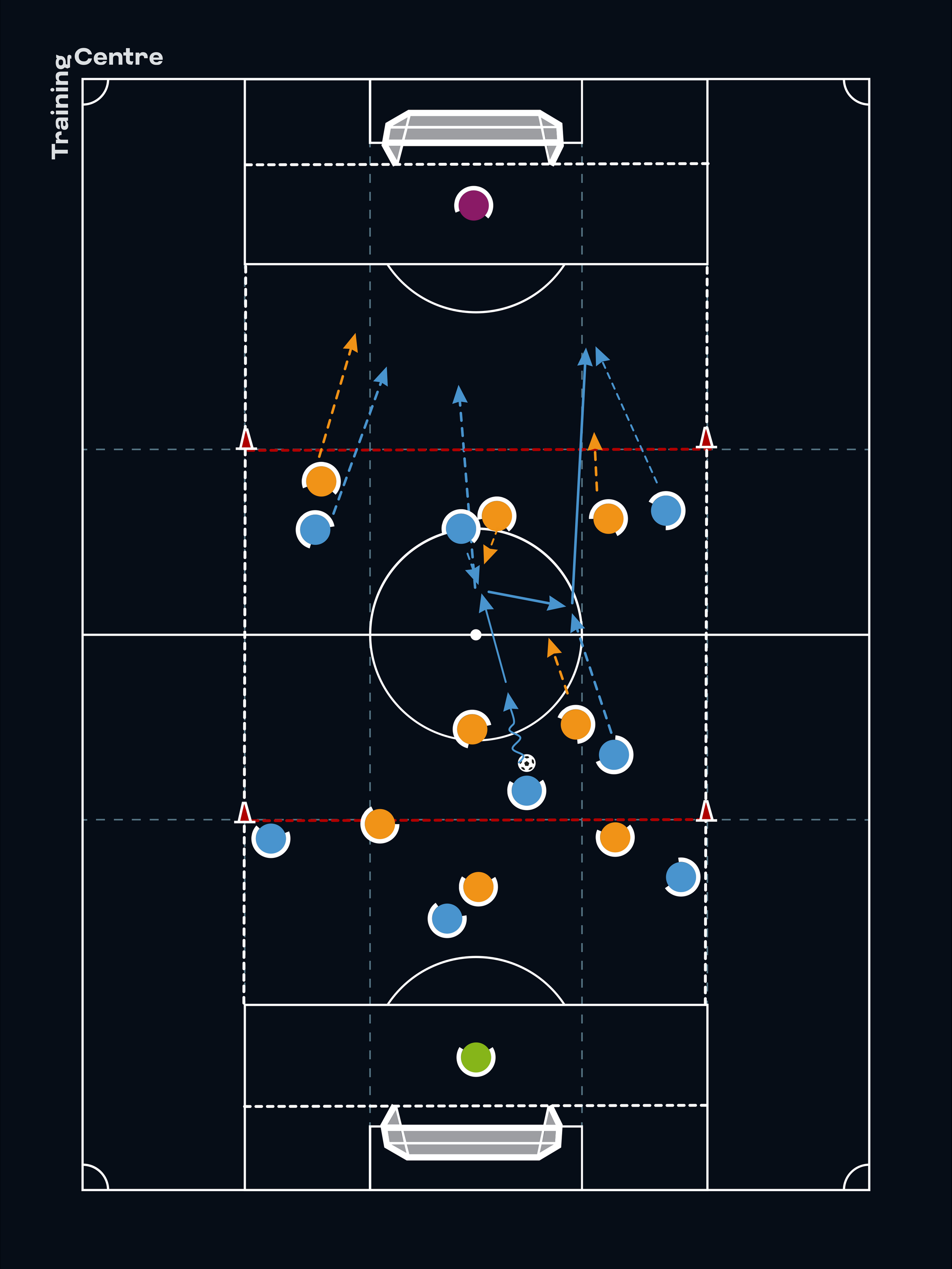
The session's concluding activity builds on the previous game. The pitch and teams are the same, and the offside lines are still marked, but the attacking team no longer has to progress forward through the zones – players can go wherever they want. This creates an even more realistic training scenario for match play, although it provides fewer repetitions. Potential receivers need to take off before the pass is played, making diagonal runs away from their opponents into space. And, most importantly, after winning the ball, the first glance should always be forward!
-
Mark out an 80x42m pitch with 2 "offside" lines as in the previous activity.
-
Divide players into 2 teams of 8 plus goalkeepers. Each team sets up in a 3-2-3 formation as before, but players are no longer limited to their starting zones.
-
As before, the attacking team tries to play out from the back and score, but now players are free to go anywhere on the pitch. Teams play 8v8, with a strong emphasis on playing balls in behind the defence.
-
The coach keeps the game moving and lets players play without interruption.
-
Attacking players: position yourself so that your field of vision is as wide as possible. Make direct or angled runs into space (in the opposite direction to the defender), and use deep runs to drag defenders out of position. Always start your runs before the pass is played.
-
All players: watch for space created by team-mates' runs, and play all passes and lay-offs with the appropriate weight and pace. As soon as the ball crosses the line, move as a unit towards goal and try to get a shot away quickly, before your opponents can win the ball back. Always coordinate the timing of your runs and passes!














